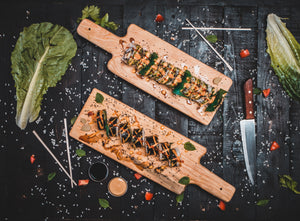Japanese knives are legendary for their sharpness. There is a whole cult around them, consisting mostly of professional chefs, knife collectors and craftsmanship enthusiasts. Let's explore why...
1. Bladesmiths emerged from swordsmiths
Bladesmiths emerged from swordsmiths in Japan, a transition that happened less than 200 years ago. For this reason, a lot of the crafts that were used to make samurai swords are now used to make kitchen knives.
2. Sharpening techniques
So the craftsmanship is the beginning of the knife cult. Each craftsman adds his own flavour to his knives by his choice of steels, shape of handles and sharpening style. In the west we are used to having a 50-50 sharpening or V-shape blade. This means that you sharpen each side equally. In Japan this is called western style sharpening. The traditional japanese style is single side sharpening, or 100-0. And for master craftsmen, there are combinations in between, with 90-10 being very popular. This mean that you sharpen one side of the blade 9 times more than the other, resulting in a very sharp edge.
3. Steel
Japan doesn't produce much steel. They import most of the iron and coal to make their steel. Over the years they have created very high grade steels, low in impurities and able to address the needs of modern professional and home kitchens. The latest trend is powder steel, which is perfect for extremely sharp knives with good edge retention. Also the VG series are very good for any knife enthusiast, as they retain their edge pretty well for home use and are easy to sharp and maintain.
Each craftsman chooses a few steels he prefers to work with. They become part of his signature.
Suwada offers a collection of handmade blades that are stainless outside but with a white steel core (shirogami 2). This offers very easy sharpening at home, great edge retention, super sharpness and minimum maintenance, using a drop of olive oil before putting it back.
4. Variety of styles
Japanese tools are built for a single purpose each. They are not as utilitarian as european tools. This rule applies to knives as well. There are more than 100 standardised knife styles in Japan. Most are used in the fishing industry and about 30 are build specifically for kitchens. Just to name a few:
- Gyuto: chef's knife
- Santoku: multipurpose
- Nakiri: vegetable knife
- Petty: smaller knife to be used alongside a gyuto or a santoku
- Sujihiki: Meat slicer
- Hankotsu: Butcher's knife for hanging meat
- Deba: Fish knife
- Unagisaki: Eel filleting knife
- Sobakiri: Soba cutter
And many many more...
On top of these traditional styles, each knife can be made with a variety of handles. Replaceable wooden handles are very popular in Japan whereas in the west we prefer to have fixed handles. Furthermore a handle is designed for better grip, ease of use and sometimes either left or right hand use. There is a serious amount of choices.

5. Small VS industrial production
Most people who prefer Japanese over western knives will tell you that it is because of the smaller production. Knife makers in Japan are mostly family run companies, usually with a master blacksmith on top leading both the production and the management. Slow, rooted in the traditional crafts, these companies have no intent to boost their production and drop the quality. They are satisfied. On the contrary, in the fast moving western world, mass produced knives are the norm with a few notable exceptions.
It can be compared to cars. Mass produced cars have standard prices and features. If you want a car to drive down the road, any car can do it. But if you want to drive fast, safely and in style, you need a supercar, or a custom car. Japanese knives are the supercars in the world of chefs. High quality, precise engineering and single purpose, small production and handmade parts.
So having a supercar is therefore a concept that can be applied in your kitchen.
Conclusion
Although this is but a short guide to the niche of Japanese kitchen knives, it gives you an understanding of the complexities and small differences between knives and their makers. It is an ongoing story of tradition, design, strong characters and delicious results!


